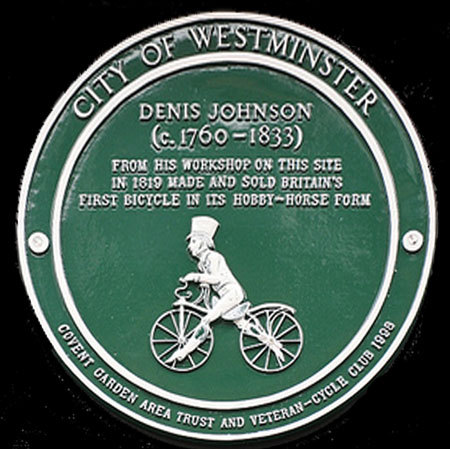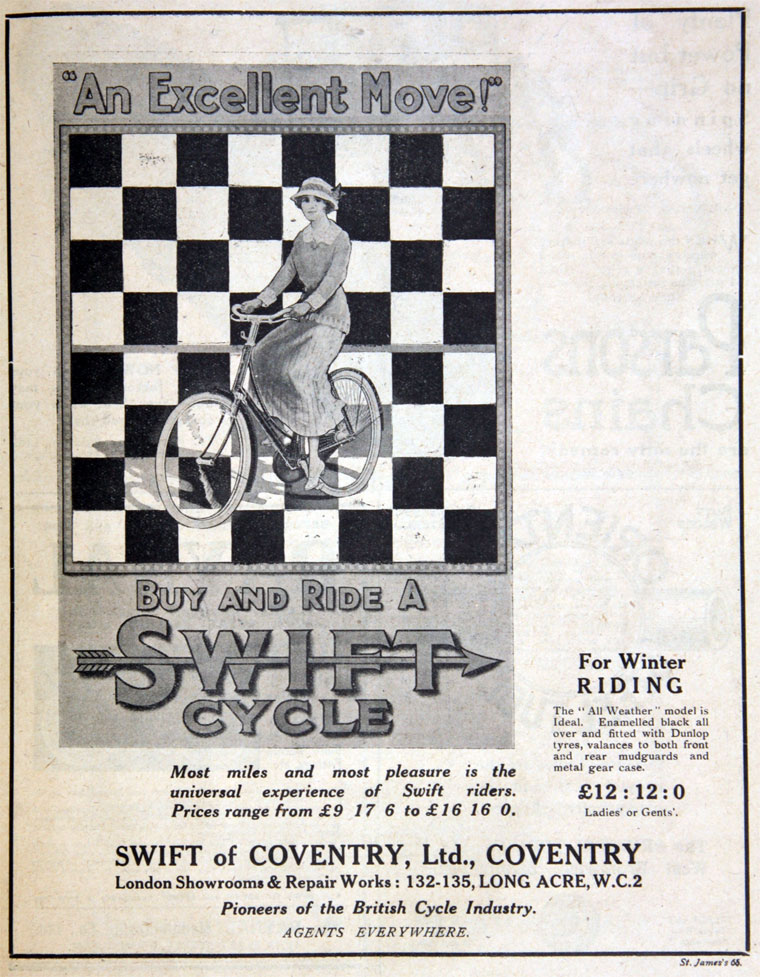

The Coventry Sewing Machine Co. was set up in King Street, Cheylesmore, Coventry, c1859 by James Starley and Josiah Turner to import and market sewing machines from America. Later they manufactured their own sewing machines and changed the name to The Coventry Machinists Co. In 1869 they started to manufacture velocipedes, bicycles, tricycles and quadricycles and became the second largest cycle maker in Great Britain under the name of the Swift Cycle Co. They produced a vast range of these machines, one model being named the “Swift” and another the “Club” as many cycle clubs were being set up at that time.
In 1898 they produced their first motor cycle and a motor tricycle. The first prototype car was made in 1900 which went into production in1901. It had a tubular chassis, a single cylinder de Dion engine and a two-speed back axle. The Swift Motor Co. was formed in 1902 and produced one, two, three and four-cylinder cars, first using proprietary engines up to about 1907 and then those designed by their Works Engineer, William Radford, which were made in their own factory. During the early 1900′s Swift entered their cars in reliability trials and won many gold medals. Up to 1915 several models were produced each year.
During the First World War the factory produced munitions, Renault and Hispano-Suiza aircraft engines, military bicycles and other war equipment. In 1919 the Company joined the ill-fated Harper-Bean organisation and changed its name to Swift of Coventry Ltd. Production was then concentrated on the four-cylinder 10hp and 12hp models which were renowned for their reliability. Although Swifts had their faithful followers, by the late 1920′s their hand-built cars could not compete with the mass-production methods of Morris, Austin, and Ford, whose similar cars sold for only half the price of Swifts. In spite of producing a cheaper 8hp model, the Cadet, with a Coventry Climax engine and a centre-change three-speed gear box in late 1930, this was insufficient to save the Company and the factory closed its doors for the last time in April 1931.
– The Swift Club – http://www.theswiftclub.co.uk/
With the company being founded by James Starley in 1859, Swift Cycle Co adverts often proclaimed: PIONEERS OF THE BRITISH CYCLE INDUSTRY. With such a distinguished place in cycling history, the Swift Cycle Co produced distinctive bicycles. The more expensive models sported duplex forks, generally considered the ‘preserve’ of top manufacturers such as Humber, Centaur and Ariel. After WW1, the company changed their name to Swift of Coventry and their bicycles featured a chainwheel spelling out the name ‘SWIFT’ as well as a unique ‘S’ lamp bracket. But, as you can see here, the chainwheel on earlier Swift machines was in the shape of a pentagram. By the time this machine was produced, the company was focusing mainly on its motorised departments.
In 1914 Swift, like other cycle manufacturers, turned its factory over to war work and scaled down its cycle production, except for machines supplied to the Government for military use. It’s likely that this 1915 Swift Imperial Roadster was used either in the field or as a mount for an officer at home. The photo below is of Bert Hambling of the 26th Middlesex Cyclist (Rifle) Volunteers ca. 1898-9.


1915 Swift Imperial Gents Roadster
Three-Speed Sturmey-Archer ‘Model FX’ Gears
24″ Frame
28″ Wheels
Frame No 606005
Swift Cycle Co Saddle
Swift Cycle Co Toolbag
Swift Cycle Co Inflator Pump
(Now sold)







SWIFT CYCLE Co Ltd
LONDON SHOWROOMS & REPAIR WORKS
132-134 Long Acre, Covent garden, London

Although Swift Cycle Co adverts claim its formation, as the Coventry Machinists Co in 1859, written history of james Starley shows the date as 1861:
May 14th, 1861, Starley left Newton, Wilson & Co and, with Josiah Turner and Silas Covell Salisbury, an American, went to Coventry to embark in the sewing machine trade. Salisbury and Starley patented a sewing machine. They rented part of the premises of a Mr. John Newark, on the site later occupied by the Swift works but the business did not prosper.
Local interest in finding work for under-employed watchmakers and those from the ribbon trade led to the formation of the European Sewing machine Co to make sewing machines, which retained the services of Messrs. Turner and Starley. The works were initially in Little Park Street, later in King Street. Soon a larger factory was needed where the ‘European’, ‘Godiva,’ ‘Express’ and ‘Swiftsure’ sewing machines were made. The company became the Coventry Sewing Machine Co, then the Coventry Machinists Co and later Swift Cycle Co.
Like many cycle manufacturers based in the Midlands, Swift Cycle Co Ltd had a showroom in London. Theirs was in Long Acre, Covent Garden, a centre for businesses connected with the cycle industry and motor trade.

Long Acre’s most famous cycle manufacturer is Denis Johnson, who had a workshop at 69-75, Acre House. His Hobby Horse – he called it a pedestrian curricle – was an improved version of the German Draisene, invented by Karl Drais. This forerunner of the bicycle was also known as a Swift Walker. He made at least 320 machines in early 1819 and, in May of that year, introduced a dropped-frame version for ladies to accommodate their long skirts. He also opened riding schools in the Strand and Soho.
For about six months the machine had a high profile in London and elsewhere, its principal riders being the Regency dandies. About eighty prints were produced in London, depicting the ‘hobby-horse’ and its users, not always in a flattering light. Johnson’s son undertook a tour of England in the spring of 1819 to exhibit and publicise the item. Nevertheless, by the summer of the same year the craze was dying out, and a health warning against the continued use of the velocipede was issued by the London Surgeons.
In Johnson’s machine, like that of von Drais, propulsion was simply by ‘swift walking’, with the rider striking his (or her) feet on the ground alternately. However, it led directly (albeit after a long delay) to the invention of the bicycle in the 1860s, when rotary cranks and pedals were attached to the front-wheel hub of a machine based on Johnson’s.

The coachbuilding trade dominated Long Acre in the nineteenth century – in 1906 41 buildings in the street were occupied by firms associated with transport, a mixture of traditional coachbuilders and those connected with the motor trade. By 1916 the transition to motor cars and related trades was almost complete. The Mercedes showroom was at number 127 to 130, close to Daimler and Fiat. At number 132 in 1929, John Logie Baird made the first British television broadcast.























1914 STURMEY-ARCHER MODEL FX 3-SPEED HUB

The Sturmey Archer FX hub was made in 1914 only, so nowadays it’s a rare hub. According to Tony Hadland’s The Sturmey-Archer Story:
By 1913 Sturmey-Archer’s three-speed hub production reached 100,000 per annum. In 1914 20,000 Raleigh bikes were factory-fitted with Sturmey-Archer gears – over one third of Bowden’s total production. In the same year the company bought the Armstrong-Triplex Three Speed Company from the New Hudson Cycle Company for £6000.
However, it seems that Sturmey-Archer produced relatively few three-speeds during the war. In 1914 the Type X was abandoned in favour of the type A …thus the machinery previously used solely for the type X would have been liberated for Sturmey-Archer’s contribution to the war effort.























1910 STANLEY CYCLE SHOW:
Stand No 57: For many years past the Swift Cycle Company has abstained from exhibiting at any cycle show, and their return to this form of publicity will no doubt be of very great interest to cycle agents generally who will iind a big range of 1911 models for their inspection.
The Swift No. 1 model is claimed by its makers to be the very last word in cycle refinement,. It is a handsomely finished machine, fitted with oil bath gear case, three-speed gear, aluminium rims, Dunlop tyres, and the Swift patent detachable “jaw plate,” which fitment makes it an easy matter to remove the tyre without disturbing the gear case and wheel bearings.
Other models which may be seen on the stand are the Special Tourist machine fitted with extension mudguards, oil bath gear case with open centre, Dunlop tyres. Sturmey-Archer three speed gear, which, listed at £10 17s. 6d., is bound to find much favour amongst buyers.
There will also be the Swift Royal Club single-geared model, listed at £8 17s. 6d. a machine which enjoys great popularity all over the country. It is interesting to note that the Royal Club is the oldest-named bicycle on the market.
The competitive Swift is the Swift imperial, which is a really high-class machine for the money. Taking the Swift 1911 models all round, we understand that the value has been greatly increased and the profit margin widened, and so thoroughly has the buyer’s side of the cycle been considered that sales should be greatly facilitated, a point of the utmost importance when the shortness of the period over which cycle selling extends is borne in mind.



Denis Johnson info – http://en.wikipedia.org/wiki/Denis_Johnson_(inventor)
Long acre info – https://en.wikipedia.org/wiki/Long_Acre,_London
Bert Hambling of the 26th Middlesex Cyclist (Rifle) Volunteers ca. 1898-9 – http://www.25thlondon.com/bicycle.htm






















































